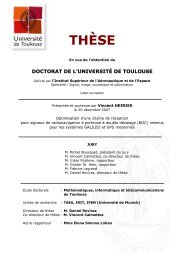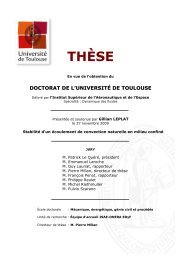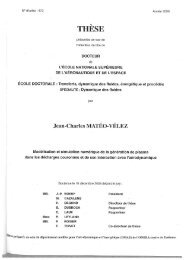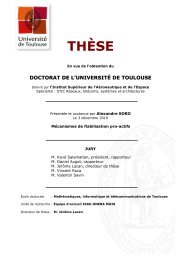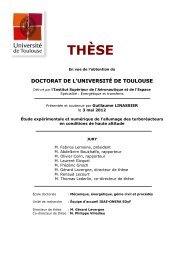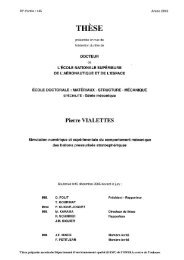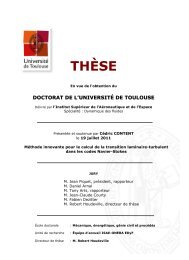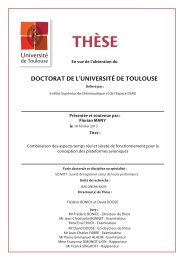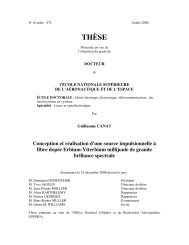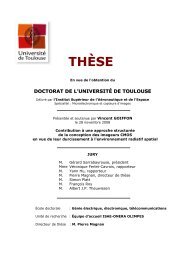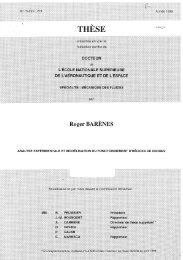Commande boucle fermée multivariable pour le vol en ... - ISAE
Commande boucle fermée multivariable pour le vol en ... - ISAE
Commande boucle fermée multivariable pour le vol en ... - ISAE
Create successful ePaper yourself
Turn your PDF publications into a flip-book with our unique Google optimized e-Paper software.
<strong>Commande</strong> <strong>bouc<strong>le</strong></strong> <strong>fermée</strong> <strong>multivariab<strong>le</strong></strong> <strong>pour</strong> <strong>le</strong> vo<strong>le</strong>n formation de vaisseaux spatiauxCette thèse traite du contrô<strong>le</strong> du <strong>vol</strong> <strong>en</strong> formation de vaisseaux spatiaux. Le <strong>vol</strong> <strong>en</strong>formation permet de réaliser de nouveaux scénarios de missions. De par la diversité desapplications <strong>en</strong>visageab<strong>le</strong>s, <strong>le</strong>s travaux sont divisés <strong>en</strong> deux parties.Dans la première partie, restreinte au contrô<strong>le</strong> des c<strong>en</strong>tres de masse des vaisseaux, uneapproche est proposée <strong>pour</strong> modéliser <strong>le</strong>s orbites relatives <strong>en</strong>tre deux satellites <strong>en</strong> orbiteterrestre, t<strong>en</strong>ant compte de l'aplatissem<strong>en</strong>t de la Terre. Fondée sur <strong>le</strong> scénario d'unemission <strong>en</strong> orbite de transfert géostationnaire, la problématique d'une dynamique àparamètre variant est illustrée. Deux manières différ<strong>en</strong>tes d'asservir la position relative sontprés<strong>en</strong>tées : la première a recours à la représ<strong>en</strong>tation linéaire fractionnaire <strong>pour</strong> obt<strong>en</strong>ir uncorrecteur auto-séqu<strong>en</strong>cé ; la seconde utilise la synthèse H2 et un modè<strong>le</strong> de référ<strong>en</strong>ce <strong>pour</strong>synthétiser un correcteur interpolé.Dans la deuxième partie, traitant des 6 degrés de liberté de chaque vaisseau, des modè<strong>le</strong>sgénériques <strong>pour</strong> la cinématique, la dynamique et la métrologie d'une formation de vaisseauxspatiaux <strong>en</strong> orbite non planétaire sont proposés. La mission exemplaire Pegase estcomposée de trois vaisseaux. Dans son mode d'observation, qui requiert un mainti<strong>en</strong> précisdes positions et des attitudes des vaisseaux, il est possib<strong>le</strong> d’utiliser des techniques decommande <strong>multivariab<strong>le</strong></strong>. La commande H2 est utilisée <strong>pour</strong> satisfaire <strong>le</strong>s spécifications de lamission Pegase. Ensuite, deux problématiques particulières sont traitées. Premièrem<strong>en</strong>t, lacommutation <strong>en</strong>tre correcteurs conçus <strong>pour</strong> différ<strong>en</strong>ts modes est considérée.Deuxièmem<strong>en</strong>t, un correcteur H2 déc<strong>en</strong>tralisé est synthétisé grâce à un algorithme itératif.Mots clés :<strong>vol</strong> <strong>en</strong> formation - vaisseaux spatiaux - modélisation cinématique et dynamique -modélisation métrologique - synthèse de correcteurs <strong>multivariab<strong>le</strong></strong>s - correcteurs à gainséqu<strong>en</strong>cé - commutation <strong>en</strong>tre correcteurs - correcteurs déc<strong>en</strong>tralisésClosed-loop <strong>multivariab<strong>le</strong></strong> control of formation flying spacecraftThis thesis deals with the control of formation flying spacecraft. Formation flying <strong>en</strong>ab<strong>le</strong>snovel space mission sc<strong>en</strong>arios. Because of the diversity of pot<strong>en</strong>tial applications, thedevelopm<strong>en</strong>ts are subdivided into two parts.In the first part, which is restricted to the control of c<strong>en</strong>ter of mass relative motion, aframework for modeling relative orbits betwe<strong>en</strong> two formation flying satellites in Earth orbitsis proposed, accounting for Earth oblat<strong>en</strong>ess. Based upon the sc<strong>en</strong>ario of a mission ingeostationary transfer orbit, the chal<strong>le</strong>nges associated with parameter-varying dynamics areillustrated. Two differ<strong>en</strong>t techniques for relative position control are pres<strong>en</strong>ted: the first onemakes use of the linear-fractional repres<strong>en</strong>tation in order to obtain a self-schedu<strong>le</strong>dcontrol<strong>le</strong>r; the second one resorts to H2 control and a refer<strong>en</strong>ce model for synthesizing again-schedu<strong>le</strong>d control<strong>le</strong>r.In the second part, which deals with the 6 degrees of freedom of each spacecraft, g<strong>en</strong>ericmodels describing kinematics, dynamics, and metrology of a spacecraft formation in a nonplanetaryorbit are developed. The exemplary mission Pegase consists of three vessels. Forits observation mode, which requires a precise position and attitude control, use of<strong>multivariab<strong>le</strong></strong> control techniques is possib<strong>le</strong>. In order to satisfy the specifications of themission Pegase, H2 control is used. Th<strong>en</strong>, two particular chal<strong>le</strong>nges are treated. Firstly,switching betwe<strong>en</strong> control<strong>le</strong>rs designed for differ<strong>en</strong>t operating modes is considered.Secondly, a dec<strong>en</strong>tralized H2 control<strong>le</strong>r is designed using an iterative algorithm.Key words:formation flying – spacecraft - kinematic and dynamic modeling - metrological modeling -design of <strong>multivariab<strong>le</strong></strong> control<strong>le</strong>rs - gain-schedu<strong>le</strong>d control<strong>le</strong>rs - switching betwe<strong>en</strong>control<strong>le</strong>rs - dec<strong>en</strong>tralized control<strong>le</strong>rs



